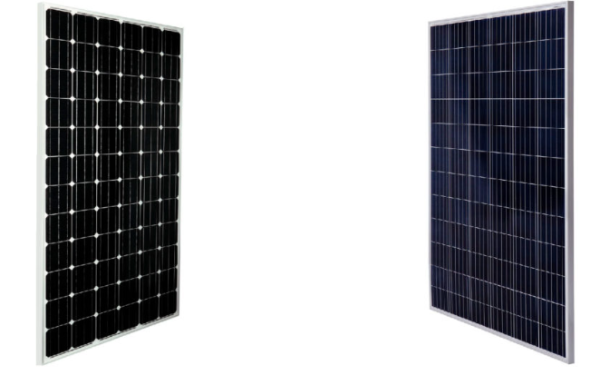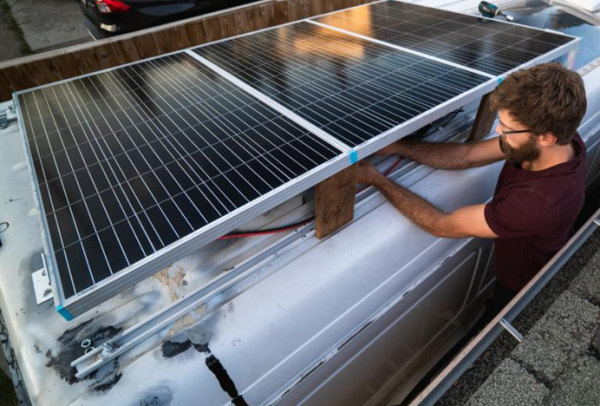In today's article, we will analyze the differences between the various types of camper solar panels. First, let's see why it is essential to have it.
Until a few decades ago, there were only two ways to charge the service battery of our camper: with the vehicle running or while connected to the 220V. Unless you brought a petrol generator with you, this has always been a limitation for lovers of free parking.
With the arrival of portable solar panels for camping on the market, the world of plain air has had an extraordinary turnaround.
The reason is straightforward: we can recharge the RV batteries with the vehicle off, wherever we are, with a reasonably low cost for building the system, provided there is enough sunlight! Greenlight, therefore, with a compressor fridge, TV, scooter or electric bike, and above all, heating or air conditioning without problems.
First, a distinction must be made between two types of solar panels for campers: monocrystalline and polycrystalline.
Monocrystalline or polycrystalline?

Monocrystalline
– The monocrystalline appears to be the panel with the best performance. Therefore, it needs a smaller surface than its brother to generate the same power, provided that there is the correct inclination concerning the sun's rays.
We distinguish it by the silicon cells blunt tending towards black, with the crystals all oriented in the same direction.
If we want to exploit this panel to its maximum potential, it would be advisable to install it on a mobile structure so that it can always be kept facing the sun with the right angle, or it should be made removable quickly to be able to position it next to the vehicle and thus obtain the maximum yield (possible only in campsites or rest areas).
The last thing to underline about this type of panel is the cost. These turn out to be slightly more expensive for the same power.
Polycrystalline
Polycrystalline, on the other hand, is less efficient with perpendicular irradiation but behaves much better when the sun's rays arrive in an oblique direction (e.g. in winter) for a satisfactory average yield for almost the entire day.
We distinguish it by bluish cells with randomly oriented silicon crystals, which is the reason for the higher yield with oblique solar rays.
As already mentioned, manufacturing these panels is less expensive, which is reflected in the final purchase price, which is, therefore, lower. The only "flaw", if it can be defined as such, is the surface, which is slightly larger than the monocrystalline at the same power.
Rigid or flexible structure?

Until recently, our choice could only fall on the classic panels with a rigid aluminium structure. Today, thanks to the development of technology, we can choose a solar panel with a flexible semi-rigid structure, fragile and easy to install.
The main differences between the two are as follows:
– THE WEIGHT: the rigid panel weighs more due to the aluminium structure and the tempered glass that protects the cells;
– RESISTANCE: thanks to the presence of tempered glass, the rigid panel will be safer against possible damage by external agents;
– THE HEAT: photovoltaic panels generate a lot of heat. A rigid board can be installed with brackets that keep it raised from the roof of the camper, while the semi-rigid would remain in contact with it, dissipating the heat that it releases inside the cell;
– AESTHETICS: indeed, a semi-rigid panel in contact with the roof of the camper will have a lower aesthetic impact than one raised by 5cm with an aluminium structure all around;
– HANDLING: the flexible panel can be handled more easily than the rigid one. It can be quickly fixed with rings to the curtains, for example, and be stored without too much effort at the end of the day or glued to the roof;
– THE PRICE: the rigid panel is the least expensive of the two, with the same power;
The last parameter: is the power of the panel.
This will essentially depend on three factors: our cell's consumption, the battery park's capacity and the space available on our roof.
As far as space is concerned, installing a 120W panel shouldn't encounter significant problems. Higher powers will correspond to larger dimensions (remember that the monocrystalline is still more undersized for the same power).
This panel can recharge a flat 12v lithium battery on a sunny day (in optimal light conditions), provided that no utilities require a lot of current in the same period.
So, if we don't have considerable demands, a 120W panel will cover all our daily absorptions and recharge the service battery simultaneously.
Do-it-yourself panel installation
As far as do-it-yourself installation is concerned, which I strongly advise against for those unfamiliar with it, you can buy these comfortable brackets, which can be glued, with this structural glue, to the roof of the camper.
Otherwise, you can rely on an aluminium corner profile installed in the same way as the previous brackets.

Summarizing the pros and cons of the various types
Well, now translating everything, we can say that the substantial differences between the different types of panels are as follows:
PROS: smaller footprint for the same power – more efficient
CONS: higher price – lower average daily return
POLYCRYSTALLINE Solar Panel
PRO: lower price – higher average daily return
CONS: larger footprint for the same power – less efficient
STIFF
PROS: resistance - price - the possibility of mounting it raised from the roof
CONS: weight - handling - aesthetics
SEMI-RIGID:
PROS: weight - handling - aesthetics
CONS: resistance - price - must be mounted in contact with the roof.
Media Contact
Company Name: Renogy
Email:Send Email
Address:5050 S Archibald Ave
City: Ontario
State: CA 91762
Country: United States
Website: https://www.renogy.com/
